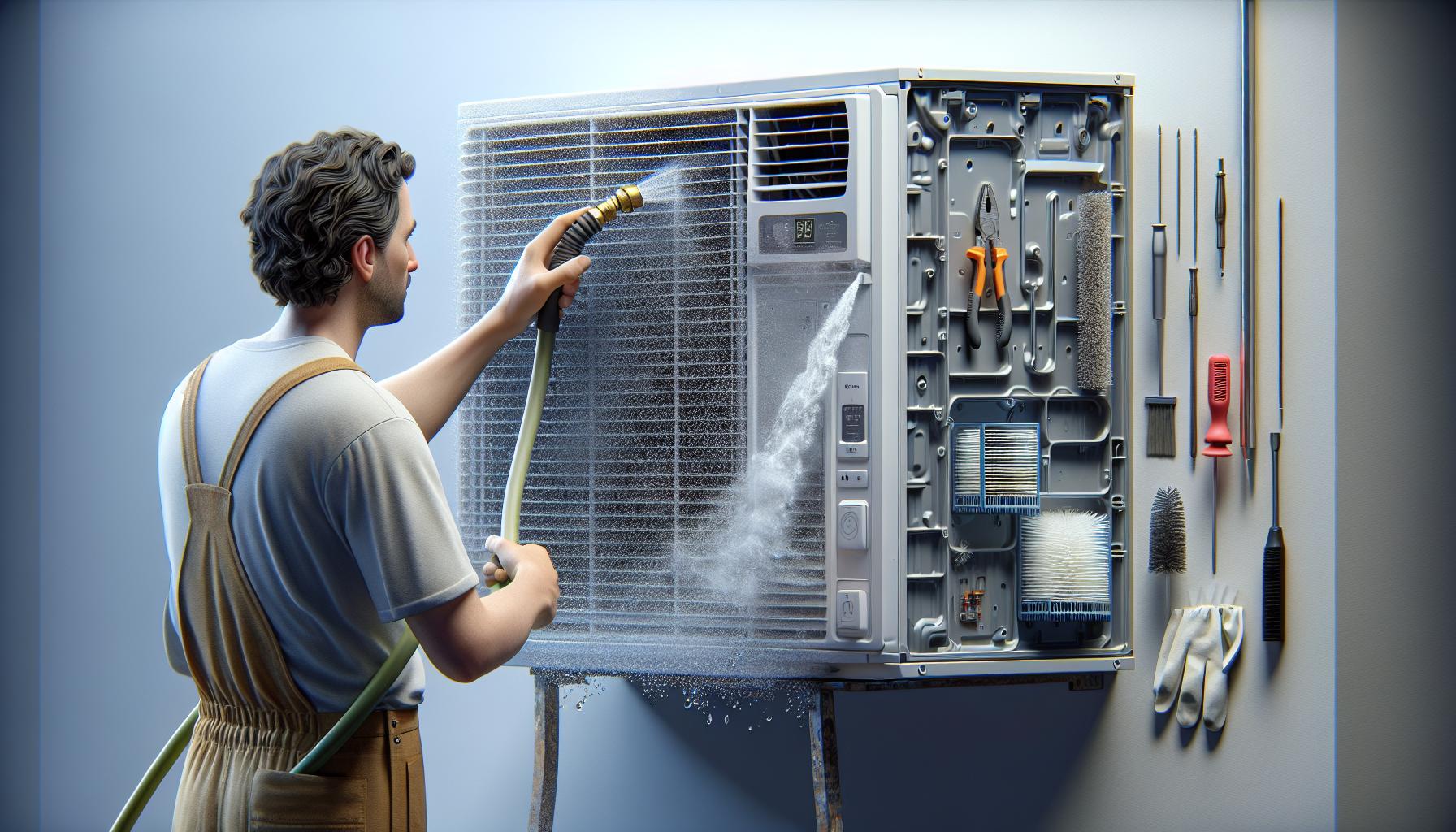When the summer heat hits, your window air conditioner becomes your best friend. But over time, dust and debris can clog its filters and reduce its efficiency. You might be wondering if you can simply hose it down to clean it out. It’s a quick solution that seems like it could save you time and hassle.
Hosing down your window air conditioner isn’t just a matter of convenience; it’s also about maintaining the unit’s performance and extending its lifespan. But, it’s crucial to approach this cleaning method with the right knowledge to avoid damaging your appliance.
Can You Hose Down a Window Air Conditioner
Hosing down a window air conditioner is a common cleaning method that many people use to maintain their unit’s efficiency. But, it’s crucial to do it correctly to avoid damage.
Firstly, turn off and unplug the air conditioner before you start. Electricity and water are a dangerous combination, and safety should always be your priority.
Remove the unit from the window if possible. This step is not strictly necessary but allows for a more thorough cleaning and lets you avoid getting water inside your home.
Be mindful of the electrical components. Use a gentle stream of water and avoid the back of the unit where the compressor and electrical components are located. The focus should be on cleaning the condenser coils and aluminum fins, which can accumulate dirt and debris.
Water can be a quick and effective way to clean out the dust, pollen, and other outdoor elements that often get trapped in the filter. After you’ve carefully rinsed these parts, let the air conditioner dry completely before plugging it back in.
Remember, while hosing down can be part of a maintenance routine, it’s also important to regularly check and clean or replace the air filter, as this is key to maintaining air flow and improving air quality inside your home.
By following these steps, you ensure your window air conditioner continues to work efficiently without risking damage to the system.
Why Would You Want to Hose Down a Window Air Conditioner?
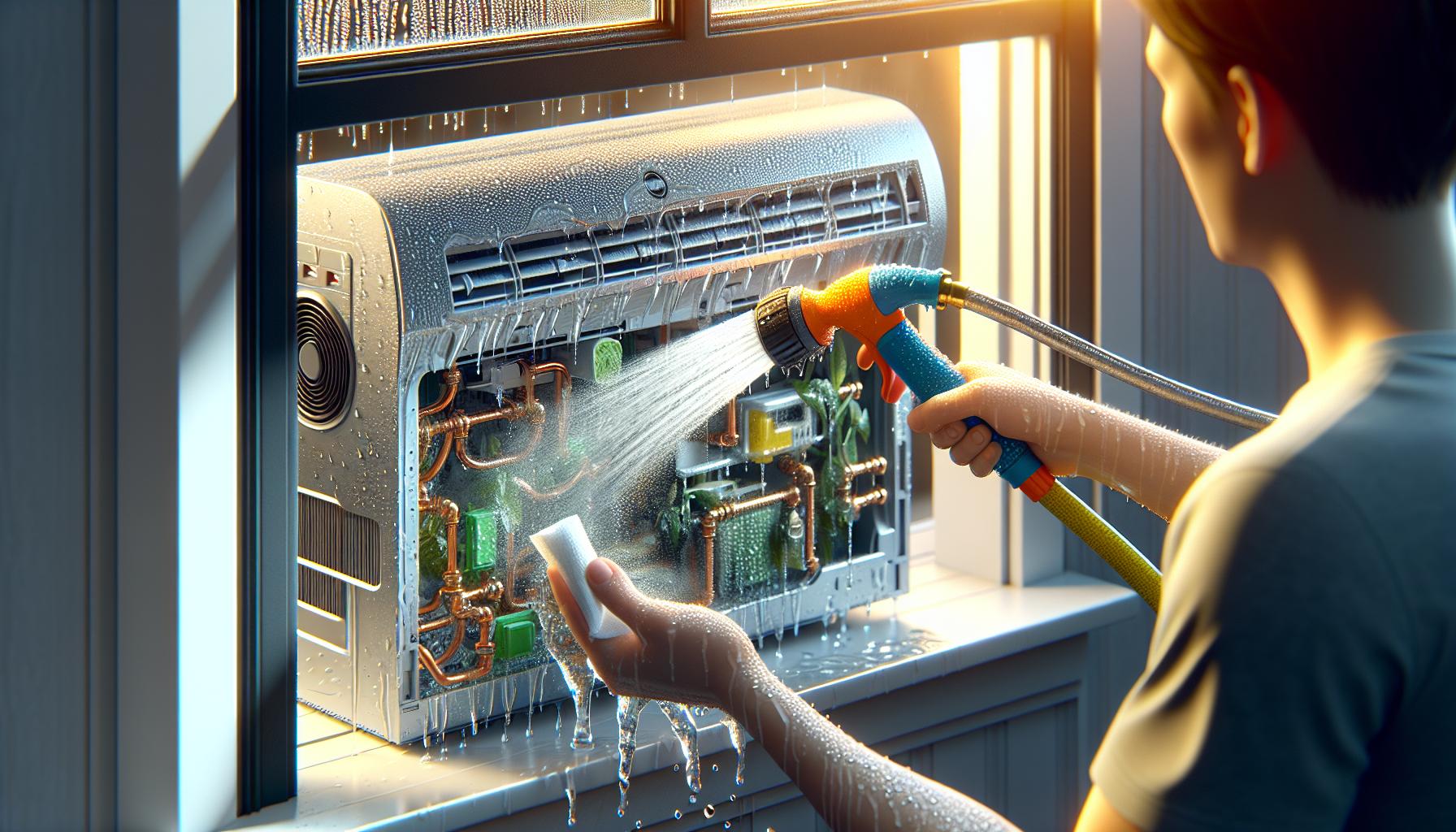
Removing Dirt and Debris
Hosing down your window air conditioner goes beyond mere aesthetics; it’s crucial for maintaining and enhancing the unit’s overall functionality. Over time, dirt, dust, and other forms of debris accumulate both on the internal and external surfaces of the air conditioner. This accumulation can lead to clogged air filters and obstructed airflow, significantly reducing the efficiency of your appliance.
By hosing down the unit, you’re essentially giving it a deep clean. This process involves removing the outer casing and using a gentle stream of water to dislodge built-up dirt from the condenser coils and aluminum fins. It’s a practical approach to prevent overheating and ensure the air conditioner operates at optimal levels.
Improving Airflow and Efficiency
The central aim of hosing down your window air conditioner is to improve both airflow and energy efficiency. When air filters and coils are clogged with debris, the unit must work harder to circulate air, leading to increased energy consumption and higher utility bills.
A clean air conditioner, on the other hand, experiences enhanced air circulation and better energy efficiency. This not only prolongs the life of the unit but also contributes to maintaining a healthier indoor air quality. Regular maintenance, including hosing down the air conditioner, ensures that the unit doesn’t harbor mold or emit unpleasant odors, both of which can affect your living environment.
By dedicating time to properly clean your window air conditioner, you’re investing in long-term savings and environmental benefits. The smoother operation of a clean unit reduces wear and tear on the components, thereby extending the lifespan of the air conditioner. Plus, with improved efficiency comes the benefit of a reduced carbon footprint, making this simple maintenance task a small but significant step towards a greener planet.
Precautions Before Hosing Down a Window Air Conditioner
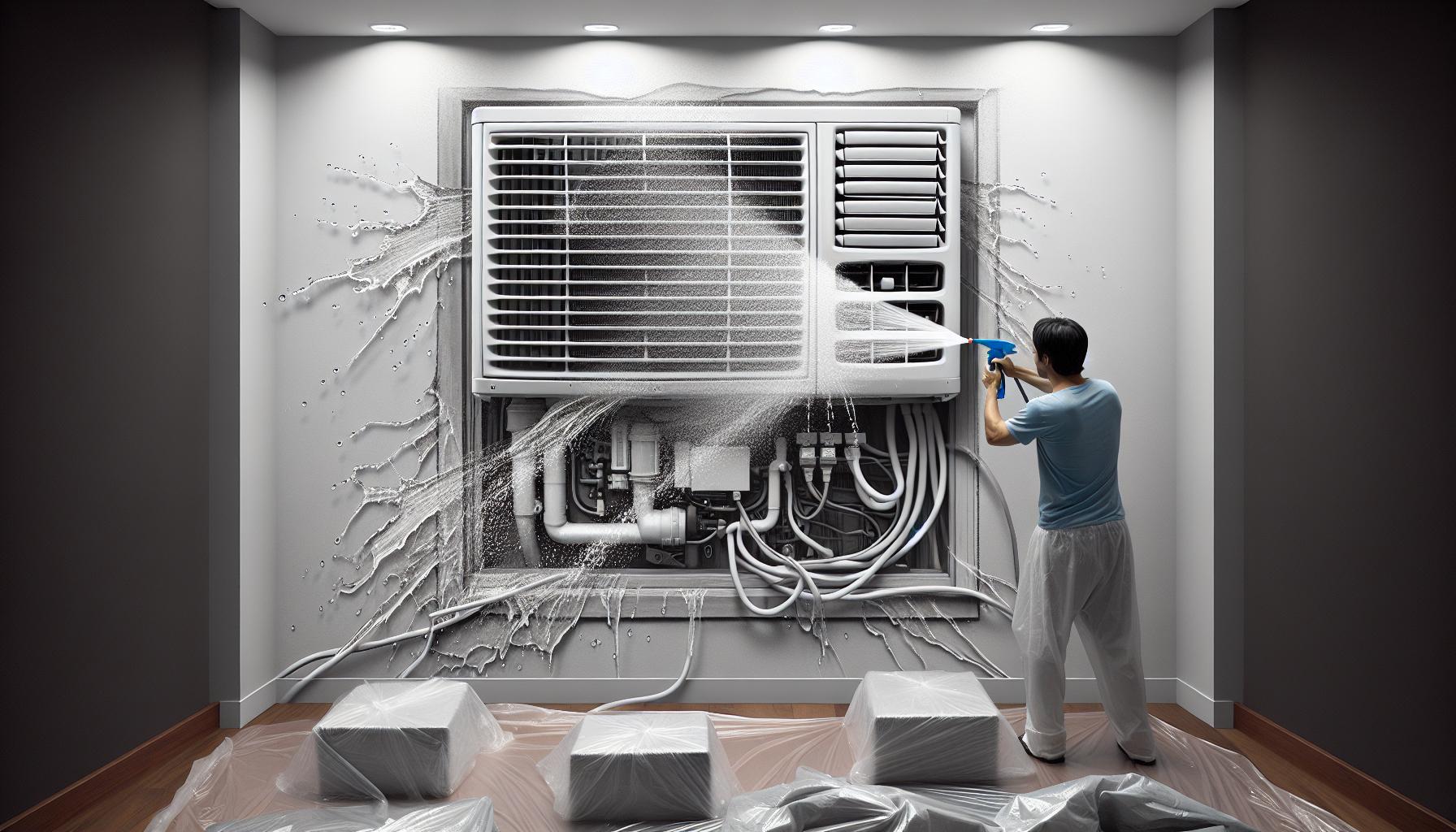
When considering the task of hosing down your window air conditioner to keep it running efficiently, it’s crucial you take the right precautions to ensure the cleaning process is safe and effective. Here’s what you need to know.
Disconnecting and Turning Off the Unit
Safety First: Before you begin, always disconnect your air conditioner from its power source. This is not just about turning it off; you must unplug it entirely or switch off the circuit breaker that powers the unit. This precaution prevents the risk of electric shock and protects the air conditioner’s components from potential damage during cleaning. By doing so, you’re not only ensuring your safety but also protecting your investment in your appliance.
Protecting Electrical Components
Keep Water Away from Electrics: The electrical components of your air conditioner are sensitive and, if not properly protected, can be damaged by water during cleaning. You’ll need to shield these parts carefully. Typically, this involves covering the motor and the electrical panel with a waterproof plastic bag or wrap. Secure these protective covers with tape to ensure they stay in place and keep water out effectively. This measure helps you avoid short circuits or corrosion that could lead to malfunctions or the need for costly repairs.
Covering Nearby Objects
Prevent Water Damage: As you hose down your air conditioner, water, dirt, and debris will run off. To protect your surroundings, it’s wise to cover nearby objects and surfaces. Use waterproof tarps or plastic sheets to shield your home’s exterior walls, windows, and any outdoor furniture. Also, ensure you’re directing the water away from electrical outlets and other appliances. This foresight not only keeps your belongings safe from water damage but also makes the cleanup process much more manageable.
By sticking to these precautions, you’re set to effectively and safely clean your window air conditioner, improving its performance and extending its lifespan. Remember, investing a bit of time and effort into maintenance now can save you from bigger issues down the line.
Steps to Hose Down a Window Air Conditioner
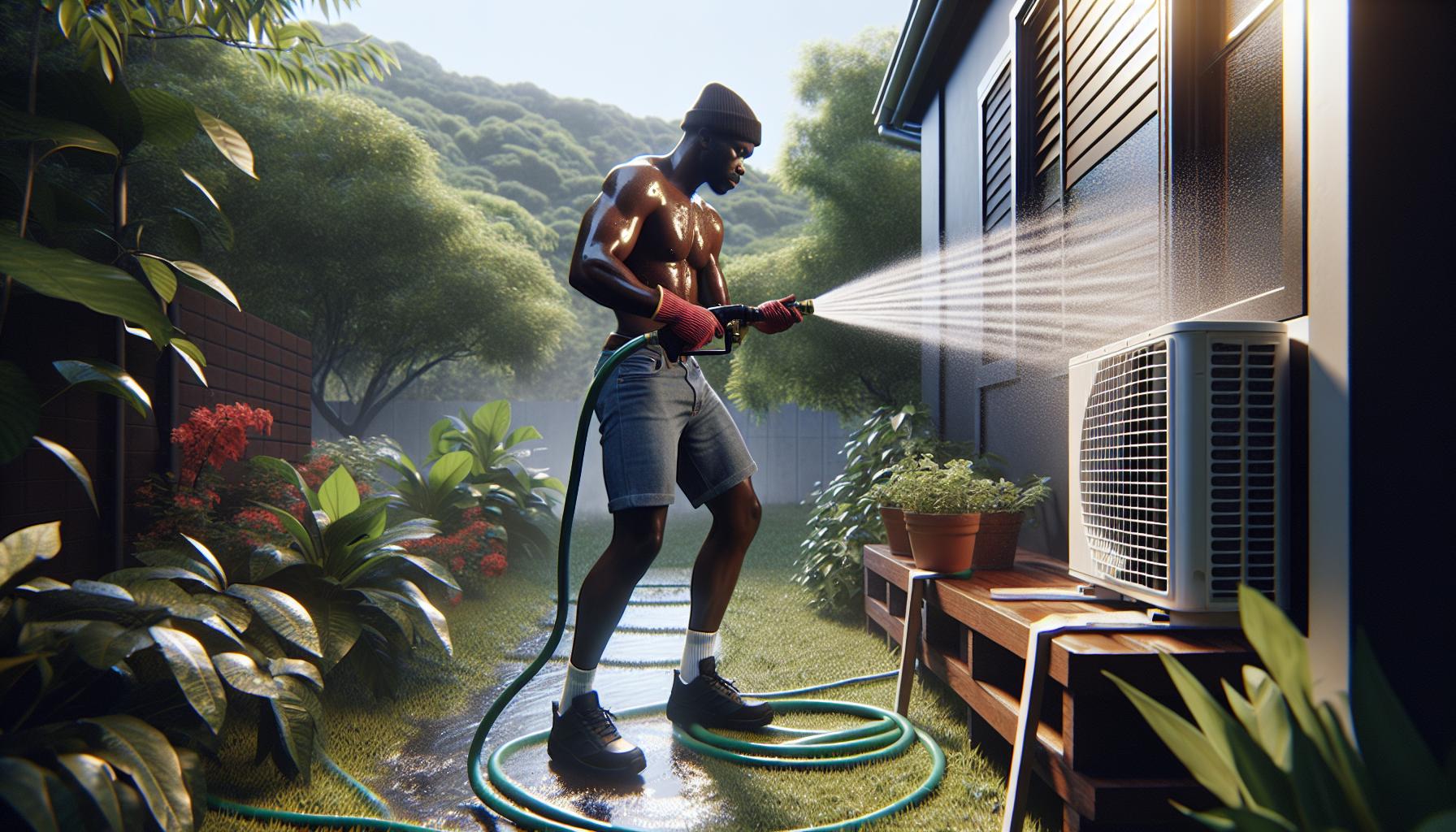
Maintaining your window air conditioner through regular cleaning ensures it runs efficiently, saving you on energy bills and avoiding costly repairs. Here s how to effectively hose down your unit.
Cleaning the Exterior
To start, ensure the air conditioner is disconnected from the power source to guarantee your safety. Begin by gently removing any visible debris from the unit’s exterior using a soft brush or cloth. This prevents the debris from getting inside the unit, which can impact its efficiency.
Next, using a garden hose on a low-pressure setting, carefully rinse the exterior of the unit. Avoid using high pressure, as it can damage the condenser coils or push debris deeper into the unit. If there’s stubborn grime, a mild soap solution can assist in loosening it, but remember to rinse thoroughly to avoid leaving any residue.
Cleaning the Filter
One of the most crucial aspects of maintaining your air conditioner is regularly cleaning the filter. A dirty filter restricts airflow, causing the unit to work harder, which, in turn, leads to increased energy usage and quicker wear and tear.
First, remove the filter according to the manufacturer’s instructions. Most filters can be cleaned with a mixture of warm water and mild detergent. After soaking for about 15 minutes, gently wash away the dirt and allow the filter to air dry completely before reinstalling it. It s recommended to clean the filter every three months or more frequently if the unit is used heavily.
Unclogging the Drainage Pipes
Finally, an often overlooked but critical step is ensuring the drainage pipes are not clogged. Blockages can cause water to back up into the unit or your home, leading to potential water damage and a decrease in the unit’s efficiency.
Locate the drainage pipe at the base of your air conditioner. Using a small, flexible brush or a piece of wire, gently remove any blockage from the pipe. For more stubborn clogs, flushing the pipe with a water and vinegar solution can help break down the blockage. After unclogging, pour water through the pipe to ensure it s clear and that water flows freely. Regularly checking and cleaning the drainage can prevent leaks and keep your unit operating smoothly.
By following these steps, you can ensure your window air conditioner performs optimally, providing you with fresh, clean air throughout the warmer months. Regular maintenance not only prolongs the life of your unit but also contributes to a more energy-efficient and cost-effective cooling system for your home.
Drying and Reinstalling the Unit
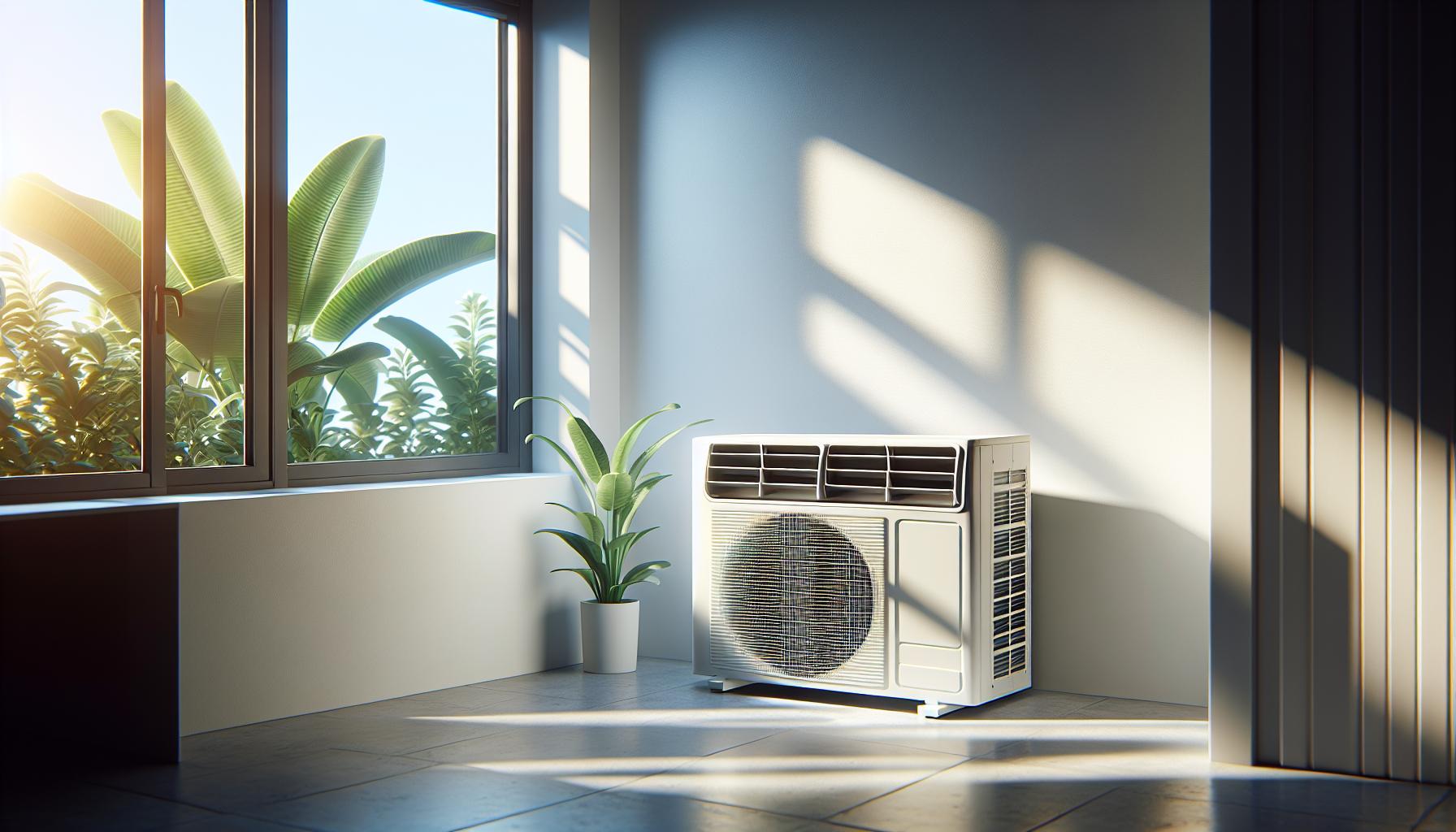
After thoroughly hosing down your window air conditioner and ensuring all parts are clean, drying the unit is crucial before reinstalling it. This step is essential to prevent any moisture-related issues, such as mold growth or electrical malfunctions. Begin by gently shaking off excess water from the components, then leave the unit to air dry in a well-ventilated area, away from direct sunlight to avoid warping or damage. This could take several hours or a full day, depending on the humidity and air circulation in the drying area.
While the main unit is drying, take this opportunity to clean the area where the air conditioner is installed. Remove any debris, dust, or leaves that might obstruct airflow or get sucked into the unit once operational. Cleaning the installation site not only ensures better air quality but also enhances the efficiency of your air conditioner.
Once you’re confident that the air conditioner and its components are completely dry, you can start the reinstallation process. Carefully place the unit back into its original position, ensuring it’s securely fitted and level to prevent any drainage issues. Reconnect the electrical components that were previously disconnected, adhering strictly to the manufacturer s guidelines. It’s beneficial to do a final check for any loose parts or potential blockages in the vents before turning the power back on.
Turning on the unit, monitor it closely for the first few hours of operation to detect any unusual noises or smells that could indicate a problem. If everything appears to be functioning smoothly, you’ve successfully cleaned and reinstalled your window air conditioner, ready to provide you with comfortable, cool air. Regular maintenance, such as the steps outlined, not only prolongs the lifespan of your unit but also ensures it operates at peak efficiency.
Conclusion
Ensuring your window air conditioner runs efficiently isn’t just about the immediate comfort of your space. It’s about taking proactive steps to maintain the unit’s health and longevity. By embracing the process of hosing down, cleaning, and drying your unit, alongside careful reinstallation, you’re not just committing to a one-time cleanup. You’re investing in the future performance of your air conditioner. Remember, a well-maintained unit doesn’t just mean cooler air. It translates to energy savings, reduced repair costs, and a longer lifespan for your air conditioner. So, take the time to care for your unit properly. Your efforts will pay off in the long run, ensuring your space remains comfortable and your air conditioner operates at its best for years to come.
Speaking of air conditioner maintenance, you might be interested in Air conditioning on Wikipedia. Additionally, if you’re curious about the impact of appliances on energy consumption, check out Energy conservation on Wikipedia. For those interested in learning more about the importance of proper appliance care, the article on Home appliances on Wikipedia can provide valuable insights.
